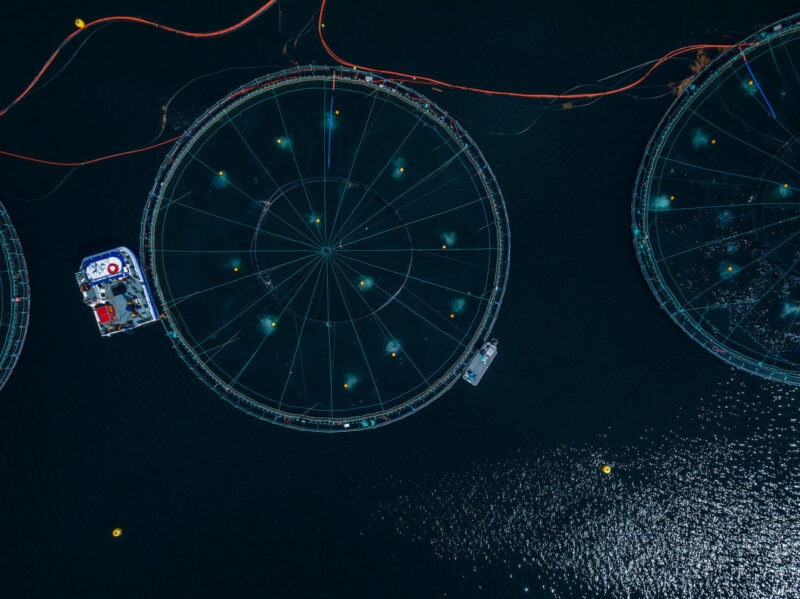Salmon farms key to Canada’s low carbon future
B.C. salmon farms emit only 2.2 kilograms of carbon dioxide for every kilogram of edible fish produced, not including the hot air by the anti-fish farm activists who want to shut them down.
By Fabian Dawson
SeaWestNews
The next time you come across a Canadian politician vowing to reduce Greenhouse Gas (GhG) emissions to combat climate change, think about this number – 22,881,000.
The number represents the increase in kilograms of Greenhouse Gas emissions should BC bow to the pressure of anti-fish farm activists, who want to replace growing fish in their natural marine environment to raising fish in massive tanks on land.
Translated, that number amounts to the energy per year needed to power a population of 52,200, or a city the size of North Vancouver.
Extrapolated globally, current estimates show that some two billion kg of salmon grown on land-based farms would produce 526 billion kg greenhouse gas emissions. Growing the global supply of salmon on land would require the same amount of energy per year needed to power a city of 1.2 million people and contribute to higher CO2 emissions.
In Canada, the transfer of the current aquaculture production from sea to land would require 33,719 acres, or 159 sq. km of land – equivalent to 28,000 Canadian football fields – to grow fish in appropriate densities in land-based systems. Raising land based salmon also costs 12 times more than ocean farming, studies have shown.
These numbers come into a foggy focus when you view them through the lens of the federal vow to create a net-zero carbon emission Canada.
Similarly it negates the promise by BC NDP party leader, John Horgan to reduce GhG emissions by 40 per cent by 2030, 60 per cent by 2040 and 80 per cent by 2050.
Neither the federal or provincial governments nor the anti-fish farm activists, have addressed the threatening increase of GhG by transitioning open net fish farms from the oceans to land-based operations in BC.
Ocean-based salmon farms in BC are powered largely by clean, limitless ocean currents, rather than electricity and oil, which positions the industry to meet the world’s growing demand for healthy, nutrient-rich protein while reducing environmental stress to our planet.
A carbon footprint measures the total greenhouse gas emissions caused directly and indirectly by the production of a product. Carbon footprint is measured in kg of carbon dioxide equivalent (CO2e) per kg edible protein of the product.
B.C. salmon farms emit only 2.2 kilograms of carbon dioxide for every kilogram of edible fish produced, not including the hot air by the anti-fish farm activists who want to shut them down.
That is less than half of any animal raised on land, including 5.1 kilograms of CO2 per kilogram of chicken, 6.4 kilograms for pork, and 37.2 kilograms for beef.
In addition, salmon are cold-blooded, so they convert more of the food they eat to muscle than warm-blooded animals do – only 1.1 kilograms of feed is needed to increase a farmed salmon’s weight by one kilogram, while it takes 1.9 kilograms of feed for chicken, 3.8 kilograms for pork and 8.0 kilograms for beef.
There is also no credible science that shows ocean-based salmon farms in BC pose a threat to wild stocks.
Earlier this year, 80,000 scientists across the world sounded an urgent climate change alarm, calling for immediate cuts to global GHG emissions, which will increase substantially, should BC bow to activism that wants salmon farmers to grow fish on land.
Last week, Bernadette Jordan, Minister of Fisheries, Oceans received a supplementary mandate letter from Prime Minister Justin Trudeau which emphasised that Canada’s Blue Economy Strategy must recognize that “clean growth is the best way to create good jobs and power our long-term economic recovery.”
Given this priority to drive post-COVID economic development through clean growth, the aquaculture industry has a central role to play in Canada’s low carbon future. Canadian aquaculture and fish processing activities already deliver significant economic benefits in Canada – mainly within rural and coastal communities where well-paying, full-time jobs are greatly in need.
In 2018, farming and fish processing activities generated an estimated $6 billion in economic activity, $2.45 billion in GDP, and full-time jobs for almost 25,000 Canadians earning an estimated $1.14 billion in wages.
“The expansion of Canadian aquaculture to meet the increased global need for high quality protein would be fully compatible with the government’s requirement for clean growth,” said Timothy Kennedy, president and CEO of the Canadian Aquaculture Industry Alliance (CAIA).
“In fact, Canadian aquaculture has the smallest environmental footprint of all animal protein-production,” he said.
As a result of aquaculture’s low carbon footprint, low land use, low freshwater consumption, and efficient feed conversion ratio, the multi-national High-Level Panel on a Sustainable Oceans Economy (HLP) identified aquaculture production as a major solution towards a lower-carbon food future.
“The largest potential (carbon reduction) gains for food production lie in the sustainable expansion of marine aquaculture,” it said.
In an open letter to Prime Minister Justin Trudeau sent yesterday, CAIA urged the government to realise the full potential of aquaculture for a low carbon food future.
“To realize this opportunity, our sector once again asks you to formally identify a federal department to champion our sustainable growth, and for this department to develop a plan and sustainable growth strategy. We ask for your government’s support on these key issues that are major blocks for our sector’s further development.”
(Aerial shot of Grieg Seafood’s Gore Island farm in Nootka Sound British Columbia.)

